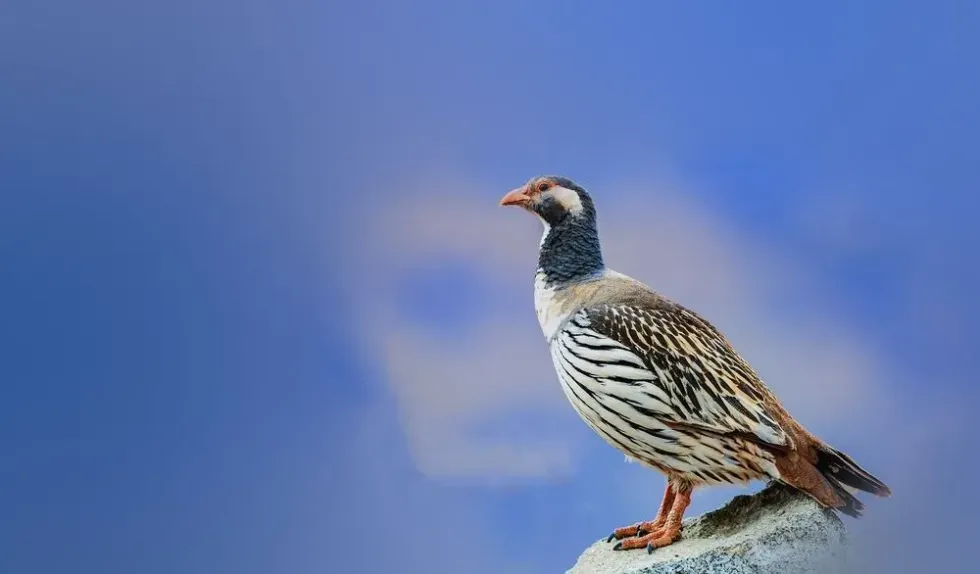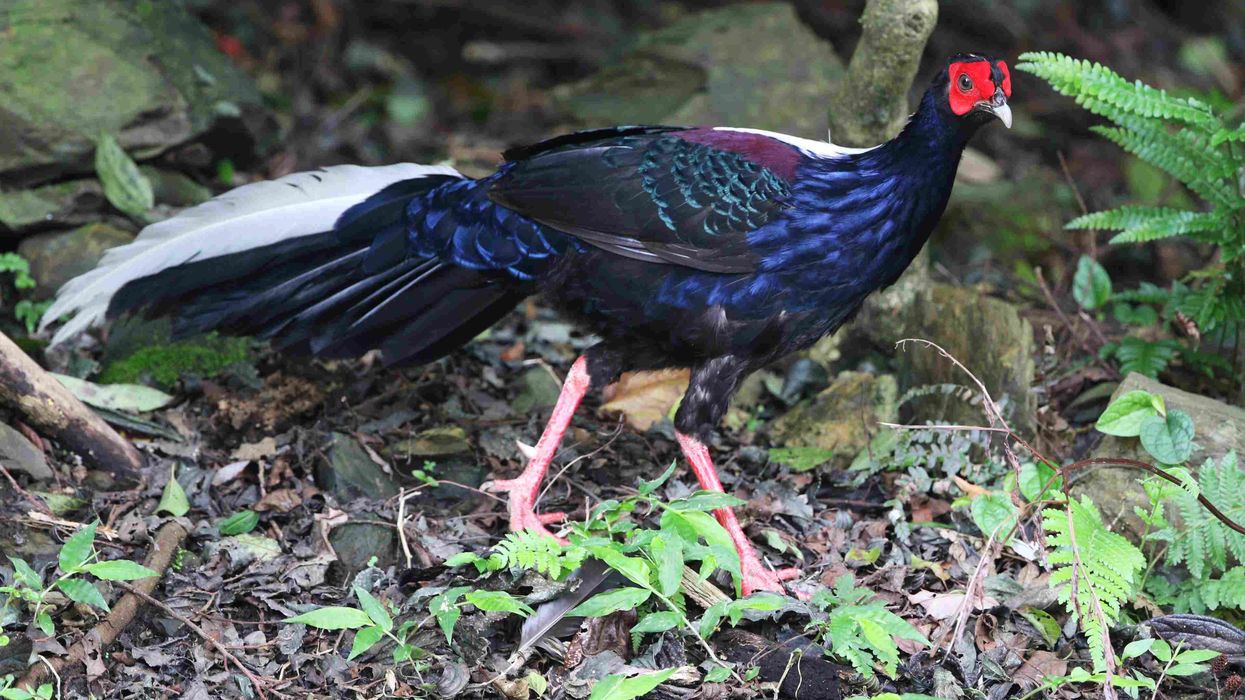The snowcock, also called the snowfowl, is a group of birds in the Tetraogallus genus. There are five snowcock species in this genus, the Himalayan snowcock, the Altai snowcock (Tetraogallus altaicus), the Caspian snowcock (Tetraogallus caspius), the Caucasian snowcock (Tetraogallus caucasicus), and the Tibetan snowcock (Tetraogallus tibetanus).
The Himalayan snowcock (Tetraogallus himalayensis) is the type species for the genus. Snowcocks are naturally found in the southern Eurasian region of the Caucasus mountains going across to western China and the Himalayas.
Caucasian, Caspian, and Himalayan snowcock birds have been introduced to the USA as well.
Snowcocks tend to live in small groups of 15-20 birds or in pairs in the breeding season. Snowcocks are mostly gray with shades of black, white, and brown.
All five species of snowcocks have been classified as species of Least Concern by the IUCN. Although, Caucasian and Caspian snowcocks face threats such as overgrazing by other animals, hunting, and military encroachment in their natural snowcock habitat.
For more relatable content, check out these tricolored heron facts and African pygmy goose facts for kids.
Snowcock Interesting Facts
What type of animal is a snowcock?
A snowcock is a type of bird.
What class of animal does a snowcock belong to?
A snowcock belongs to the Aves class of animals.
How many snowcocks are there in the world?
The exact populations of some of the snowcock species in the world are not known. However, the populations of the Caspian and Caucasian snowcock are known. There are 6,000-32,000 mature individuals of the Caucasian snowcock species and 16,000-39,999 adults of the Caspian snowcock species.
Where does a snowcock live?
Snowcocks are native to the continent of Asia. They are found in different mountain ranges of Asia and Europe.
Caucasian snowcocks are native to the Caucasus mountain range in the countries of Georgia, Azerbaijan, and Russia. This bird has also been introduced to the USA. The Caspian snowcock is native to Armenia, eastern Turkey, Azerbaijan, Georgia, Iraq, and Iran.
It has also been introduced to America. The Tibetan snowcock lives in the mountain ranges in the countries of Nepal, India, Bhutan, China, and Tajikistan.
The Himalayan snowcock bird is found in the mountain habitats of countries like Tajikistan, Afghanistan, Turkmenistan, Kazakhstan, Uzbekistan, Pakistan, Kyrgyzstan, Nepal, China, and India. It has also been introduced to the United States of America. The Altai snowcock is native to the high altitudes in the countries of China, Mongolia, Kazakhstan, and Russia.
What is a snowcock's habitat?
Snowcocks are usually found near open and steep slopes and cliffs that are above the treeline. The geographic ranges of the different species of snowcocks do not overlap, except for Tibetan and Himalayan snowcock birds. They are also found near alpine pastures, steep valleys, rocky ridges, and mountain spurs.
All the different species inhabit a combined elevation range of 1,312-19,029 ft (400-5,800 m). They exist from between the high snowline and the low treeline and are altitudinal migrants. They move close to lower elevation areas in the winter.
Who does snowcock live with?
Snowcocks live in pairs during the breeding season. Outside of the breeding season, these ground-dwelling birds may be seen in groups or flocks of 15-20 birds.
How long does a snowcock live?
Not much information is available about the longevity of snowcock birds but their generation time length is five years.
How do they reproduce?
Snowcocks reproduce by mating and laying eggs. The number of eggs laid vary with the different species, but the clutch size range is 4-12 eggs. In the breeding summer season, they live high up in the mountain areas. For the winter, they move close to lower altitude areas.
For the type species of Himalayan snowcock, the egg-laying takes place April to May. There is just one brood laid in a given year.
Also, the Himalayan snowcock is a monogamous bird species. The nest site is on the ground, in a depression that is lined with feathers and dry grasses.
The nest is protected by a boulder or a rock and is among grass tussocks or in a cave. The female usually lays eight eggs, but the clutch size can range anywhere between 6-12 eggs. The incubation is done by both male and female snowcocks but mostly by the females, for 25-28 days.
The chicks are precocial and are raised by both parents until fledging. More often than not, juvenile snowcocks stay with at least one of their parents until they reach reproductive maturity.
What is their conservation status?
According to the International Union for Conservation of Nature, the conservation status of all the five species of snowcocks is Least Concern.
Snowcock Fun Facts
What does the snowcock look like?
Snowcocks tend to be long-necked, large, bulky, and long-bodied birds that look like partridges. The females and males tend to look alike but the males are slightly bigger and the females are duller in color.
The overall coloration is gray but there are also some amounts of brown, black, and white. The under tail coverts are distinctive and white.
The overall plumage is downy and thick which comes in handy considering their snow habitats where temperatures can go down to -40 F (-4 C). Juvenile snowcocks look like adult females and it takes two years for young snowcocks to develop adult characteristics.
For the type species of Himalayan snowcock birds, the adult males look similar to gray partridges. The tail and rump of the male Himalayan snowcock bird are gray.
The back and upper wings are gray and the feathers have chestnut edges. The mantle is pale gray and the black primaries have white tips that can be seen in flight. The outer tail feathers are rufous.
The breast is pale and buffy-gray and has blackish horizontal streaking. The vent and the belly are gray-brown but darker.
There is also a dark rufous-brown colored band that runs from the backside of the eye onto the neck and forms a collar at the white throat's base. A dark-colored moustachial stripe also runs to the hindneck, joining with the collar.
The bill of the Himalayan snowcock is dark gray. The eyes tend to be brown surrounded by orbital skin that is yellow. The feet and legs are dark yellow-orange.
Also, the males have tarsal spurs which the females do not. The forehead of the female is pale buff and she has more gray around the eyes.
The juveniles are paler and do not have markings that are very noticeable. Also, the white supercilium in juveniles is conspicuous.

How cute are they?
Snowcocks are beautiful birds. They are subtly colored and large, bulky birds that blend in beautifully with their snowy and mountainous habitat. The 'falling' flight of these ground-dwelling birds is graceful and their calls are very melodious too.
How do they communicate?
Snowcocks communicate through calls and displays. The Himalayan snowcock male is known to perform courtship and mating displays which involve crouching down on the ground and fanning out its wings slightly.
The tail feathers are dropped and the plumage appears to be slightly ruffled. The male will then move in view of the female, circle, and run back and forth many times. The purpose of such displays is to fully exhibit the plumage colors.
Many loud whistles consisting of five notes are given during these displays. The typical calls of Himalayan snowcocks include chuckles, cackles, and whistles.
Snowcocks are shy birds so you are more likely to hear a snowcock sound than see an actual bird. The whistles are rather melodious and sometimes they utter a cry too.
How big is a snowcock?
Snowcocks are 21.3-28.3 in (54-72 cm) long and have a wingspan of 34-38.2 in (86.4-97 cm), which makes them five to seven times bigger than verdins.
How fast can a snowcock fly?
Little information is available about the flying speeds of snowcock birds. It is known, however, that they are large, bulky birds and cannot fly for a distance with wing-flapping. They run to high grounds and launch themselves off cliffs and glide in the air, practically falling to lower altitudes.
How much does a snowcock weigh?
A snowcock bird may weigh 4-8 lb (1.8-3.6 g).
What are the male and female names of the species?
Males and females of the different snowcock bird species may be called cocks and hens respectively.
What would you call a baby snowcock?
A baby snowcock bird would be called a chick.
What do they eat?
Snowcocks eat leaves, rushes, tubers, berries, young shoots, grasses, and fruits. They are considered herbivores but may rarely eat insects as well.
Their predators include golden eagles and snow leopards.
Are they dangerous?
No, snowcocks are not dangerous.
Would they make a good pet?
No, snowcocks are wild and beautiful birds that live in their snow-clad and scenic winter habitats. They would not make good personal pets.
According to the information made available by IUCN, the Caucasian snowcock faces threats from overgrazing of livestock and hunting. The Caspian snowcock is threatened by grazing in Europe and by military activity in Azerbaijan through poaching and possibly the spread of long-range ammunition in the field. These additional issues that humans make for snowcocks need to be fixed.
Did you know...
Snowcocks belong to the pheasant family Phasianidae.
What is the snowcock range map?
The snowcock range map runs from the southern Eurasia region, from the Caucasus region mountains across to the Himalayas as well as western China. The last additional territory included in the range map is the USA, where three of the species have been introduced.
What are the types of snowcocks?
There are five different types of snowcocks, the Himalayan snowcock, the Tibetan snowcock, the Altai snowcock, the Caucasian snowcock, and the Caspian snowcock.
Here at Kidadl, we have carefully created lots of interesting family-friendly animal facts for everyone to discover! Learn more about some other birds from our peacock interesting facts and palm cockatoo surprising facts pages.
You can even occupy yourself at home by coloring in one of our free printable sulfur-crested cockatoo coloring pages.









